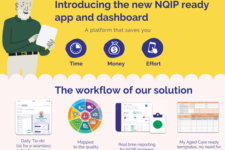With a focus on better outcomes for consumers, quality standards and accreditation processes recognise the importance of customer experience and the role of feedback in driving aged care quality.

With the introduction of the 2019 Aged Care Quality Standards organisations were required to provide evidence of a culture that welcomes and supports regular feedback.
Many providers may think that have this in hand, with complaints processes in place and annual satisfaction surveys conducted.
However, measuring customer experience is much more than measuring customer satisfaction.
“The organisation regularly seeks input and feedback from consumers, carers, the workforce and others and uses the input and feedback to inform continuous improvements for individual consumers and the whole organisation.” Aged Care Quality Standards.
To drive continuous improvement, the aim of the Aged Care Quality Standards, providers need to take a far more proactive approach.
Gathering resident, family member and customer feedback at multiple touch-points provides a more rounded picture of whether experiences meet consumer expectations of quality.
There are many ways that providers can get to understand their customers better and gain valuable insights into how they view their services. Here is a breakdown of some effective ways you can proactively gather feedback.
Customer feedback surveys
Customer feedback surveys are an effective and efficient way to gain insights on customer experience and measure what matters.
Using digital surveys can reduce the resourcing implications of gathering regular feedback and allows providers to capture valuable information from large groups of people in one form.
Pulse surveys also allow providers to gain feedback on customer experience across multiple touch-points on the aged care journey.
However, to gather valuable insights, providers need to take care in asking the right questions to deliver measuring data and ensuring surveys are easy to complete to increase completion rates.
Some useful tip on constructing effective feedback survey include:
- Make sure the questions are simple and easy to understand
- Construct smart, open-ended questions
- Ask one question at a time
- Make rating scales consistent
- Avoid leading and loaded questions
Coming up with your own questions can be a challenge, which is why it can be helpful to use a service that has pre-templated and customisable surveys.
Email and customer contact forms
Email and customer contact forms are some of the most common ways providers already gain feedback from their customers.
There are several ways providers can improve to get the most out of this feedback method, including:
- Assuring customers of a speedy response: Most customers are reluctant to leave feedback if they think it falls on deaf ears. By being responsive to customer feedback, you’re letting them know you have received it and are going to do something about it promptly.
- Creating an organised customer feedback system: It’s crucial to follow-up all customer contact and to do so you need to be organised. Keep track of all feedback, so that when follow-ups are completed you have a database of who said what and the action taken. Also take note of any repeated feedback, as this may indicate issues that need to be addressed sooner rather than later.
- Candid follow-up emails: As emails are personal and private, it’s a great way to get honest feedback. If you enter into a personable conversation with your customer, then they will see more value in you and your organisation.
Usability tests
Usability testing is a qualitative method often used in other sectors to understand how easy it is for a customer to interact with a product of service.
While this requires more planning than other feedback methods, it can deliver more detailed and nuanced insights into customer experience a different touchpoint.
In aged care, this method can be particularly useful for reviewing some of the initial customer interactions with aged care, especially those where complex information is given, such as a first meeting or facility tours.
In usability testing, a potential customer would be asked to complete specific tasks, for example, to complete admission paperwork, are asked to while they are being observed by a researcher to see where they encounter problems and experience confusion.

Exploratory customer interviews
This in-depth interviewing method can be very time consuming for providers, but it is an extremely effective way to gain more detailed insights qualitative insights and explore themes that may appear in from feedback surveys.
Exploratory customer interviews can be done via email or phone, but are best when conducted face to face (either in person or via video call). There are certain techniques you can use to get the most out of these interviews, including:
- Focus on their attitudes: Looking at attitudes will give a better understanding of what and why something matters to your customers.
- Use the critical incident method: This means asking users to recall specific instances where things didn’t work and other aspects that worked particularly well. This technique provides the opportunity to gain in-depth insights into experiences that customers value.
- Inquire about habits: Asking customers about their day-to-day habits can reveal more details about how customers interact with services, and how they can better meet their needs.
Social media feedback
Social listening is a method of scouring social media to see what people are saying about you and your organisation or brand.
Looking at social media comments is a good way of seeing candid feedback from your customers and understanding public sentiment about your brand.
Social listening is also a useful method to see what people are saying about your competitors.
The social media comments and feedback won’t necessarily be tagged to your organisations though, and sometimes a deeper search is needed to find out what people are really saying.
Website analytics
How your website performs can be a top-level indicator of customer experience, especially in aged care, where people are interacting with an emotional and complex subject matter.
Websites are often the first contact with have with potential consumers, and can leave a lasting impression of the organisations perceived quality and ability to meet the individual’s needs.
There are some simple analytics you can use as feedback indicators such as:
- Time spent on site: A sign that you need to improve onsite user experience is the length of time spent on site. Too long, and people may be struggling to navigate the site. Too short and they are not engaging with the content.
- Bounce rate: If people are visiting a particular page on your website and leaving quickly, it can be a sign that they are not finding the information they wanted.
- Return visitors: Considering return visitor to your website can you give a top line indicator of whether people are engaging with your content over time.
Chatbots
A new way some organisations are getting customer feedback is through the use of Chatbots. Chatbot surveys are sometimes known as “conversational surveys” because instead of answering static questions, the person being surveyed is invited to engage in a conversational exchange with the bot persona.
This conversational approach has been shown to improve the survey experience and make it more likely for people to complete surveys – because it becomes more fun.
Chatbots offer the benefit ask for live feedback directly on your website or social media, reducing the need for someone to navigate away to another page to complete a feedback survey or receive a follow-up survey at a later date to their inbox.
Customer feedback matters, and it is increasingly important that you make it easy for the customers to give you the information you need to make improvements.
















